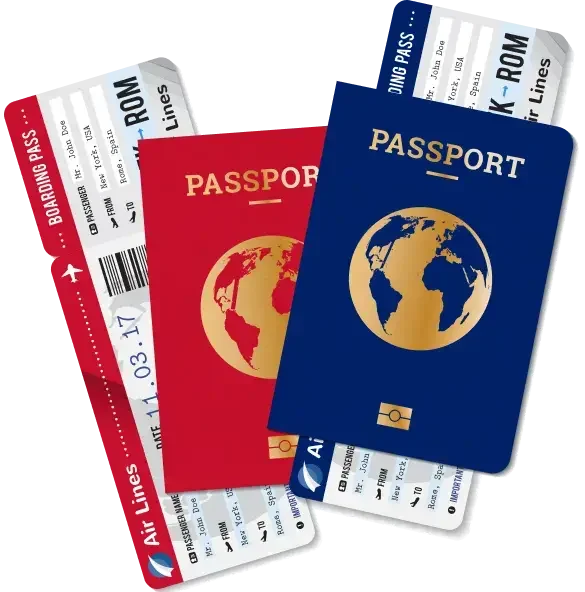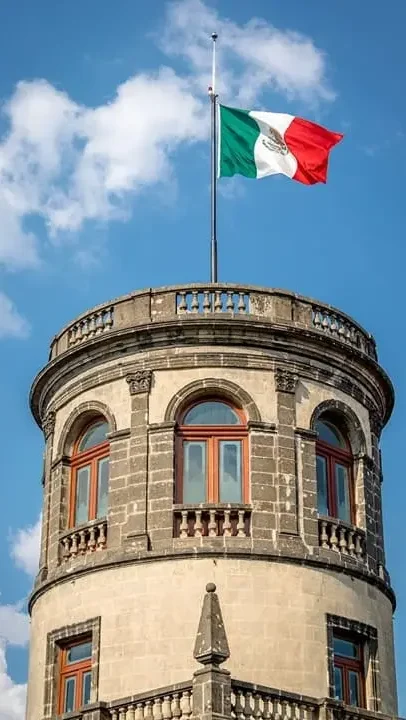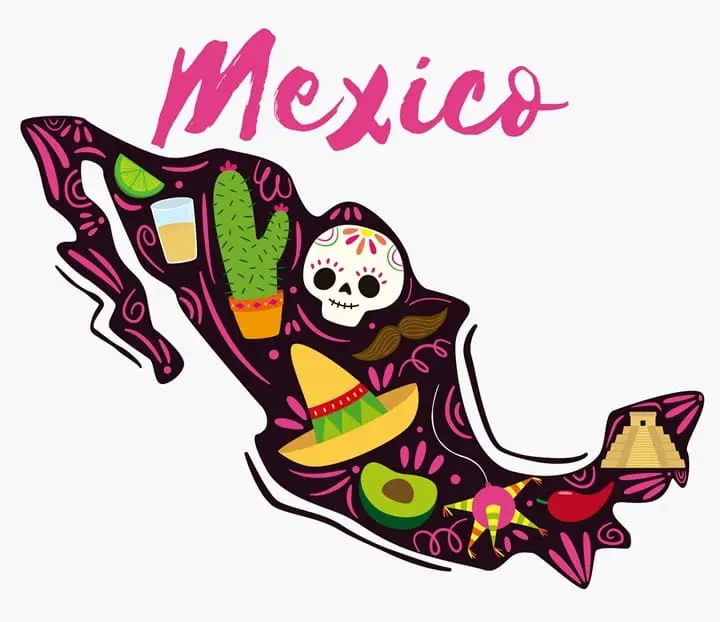Population
GDP (per capital)
Visa-Free Countries
GDP (purchasing power parity)
-
Immigration to Mexico- 2025 updates
-
Mexico continues to attract individuals seeking a better quality of life, thanks to its favorable climate, vibrant culture, and affordable living costs. Whether drawn by its coastal beauty or historic cities, many are choosing Mexico as a place to live, work, or retire. By 2022, over 1.6 million Americans had relocated there—many as digital nomads or retirees—and that number has only grown in recent years.
As of 2025, the country remains a popular destination for those looking to establish temporary or permanent residency. This article explores the main legal pathways to immigrate to Mexico, outlining key requirements, recent updates, and practical advice for a successful move. - Main Industries
- Manufacturing and Industrial Production
- Tourism and Hospitality Services
- Agriculture and Agribusiness
- Automotive and Aerospace Industry
- Oil and Gas Extraction
- Mining and Metal Production
- Food and Beverage Processing

(UTC-6)
1,964,375 km2
Mexican peso (MXN)
Mexico City
Spanish (official), 68 indigenous languages
Pathway 1: Tourist Visa (FMM)
Pathway 1: Tourist Visa (FMM)
Who It’s For
- Tourists and short-term visitors
- Individuals exploring Mexico before applying for residency
- Those attending cultural, educational, or medical visits (non-remunerated)
Important Restrictions
- Employment is strictly prohibited under this visa.
- Overstaying can lead to fines, deportation, or difficulty obtaining future visas.
Requirements
- A valid passport with at least 6 months' validity
- Proof of onward or return travel
- Occasionally, evidence of sufficient financial means for the intended stay
Fees (2025 Update)
- Approximately MXN 687 (≈ USD 40)
- Payable online before travel or at entry points (airports, land borders)
Processing Time
- Issued immediately upon arrival
- No pre-approval or consular visit required
Insider Tip: Some Mexican consulates now prefer or require that applicants for temporary or permanent residency have previously entered Mexico using an FMM. A prior visit can strengthen your case when applying for long-term visas from your home country.
The FMM serves as a convenient and low-barrier entry point for newcomers. While it does not offer a path to residency, it allows individuals to experience life in Mexico firsthand before committing to a more permanent immigration route.
Pathway 2: Temporary Resident Visa (1–4 Years)
Pathway 2: Temporary Resident Visa (1–4 Years)
The Temporary Resident Visa offers a flexible solution for those intending to live in Mexico for an extended period—ranging from one to four years—without committing to permanent residency right away. It’s particularly suitable for retirees, professionals, students, entrepreneurs, and remote workers who meet the financial or professional eligibility criteria.
Eligibility Categories
There are several qualifying routes for obtaining a temporary residency visa in 2025:
- Economic Solvency: Demonstrate either:
- A monthly income of approx. USD 4,100 (or equivalent in another currency), or
- Savings of at least USD 70,000 over the past 12 months (Figures updated in line with Mexico’s 2025 minimum wage adjustments.)
- Typical Fees:
- Consular application: USD 51–80
- INM card issuance (1 year): MXN 5,500–7,000 (~USD 325–415)
- Processing Duration:
- Consulate: 7–15 business days
- INM exchange: 2–4 weeks after arrival
- Work Permit (Employer-Sponsored)
- Must have a job offer from a Mexican company.
- The employer must initiate a request through Mexico’s National Immigration Institute (INM) before you apply.
- Typical Fees:
- INM pre-approval: paid by employer
- Consular visa: USD 51–80
- Resident card: MXN 6,000–7,000
- Processing Duration:
- INM pre-approval: 2–4 weeks
- Consulate: 1 week
- INM card issuance: 3–4 weeks
- Student, Academic, or Institutional Invitation
- Acceptance into a recognized Mexican institution (educational or research-based) qualifies for a temporary visa.
- Typical Fees:
- Visa fee (some consulates waive): USD 0–51
- Resident card (student discount often applies): MXN 4,000–5,500
- Processing Duration:
- Consulate: 5–10 business days
- INM card: ~2 weeks
Application Process
- Submit your application at the Mexican consulate in your home country. (Note: Some consulates now prefer applicants to have previously entered Mexico on a tourist visa (FMM).)
- Provide supporting documentation based on your visa category:
- Bank statements
- Proof of income or property title
- Employment contract or university acceptance letter
- Attend an in-person consular interview and receive a visa sticker in your passport upon approval.
- Within 30 days of arrival in Mexico, visit the local INM office to exchange the visa sticker for a resident card.
The Temporary Resident Visa serves as a practical and versatile pathway for those wishing to establish a deeper connection with Mexico—whether through work, study, investment, or simply long-term residence. It also lays the groundwork for transitioning to permanent residency after four consecutive years.

Pathway 3: Permanent Residency
Mexico’s Permanent Resident Visa (Residencia Permanente) offers long-term security for foreign nationals who wish to settle indefinitely in the country. Unlike temporary options, this status does not expire and eliminates the need for yearly renewals. Applicants can pursue this visa either through a gradual route or apply directly under specific conditions.
Standard Route: After Temporary Residency
Individuals who have legally resided in Mexico as temporary residents for four consecutive years become eligible to apply for permanent residency. This transition is relatively straightforward, especially for those who have complied with immigration regulations during their stay.
Note: In certain cases—such as being married to a Mexican national—the wait time may be reduced to two years.
Direct Route: Retirees & High-Net-Worth Applicants
Foreigners who meet higher financial thresholds may bypass the temporary stage and apply directly for permanent residency at a Mexican consulate abroad. This path is especially popular among retirees, digital entrepreneurs, and investors.
2025 Financial Requirements (approximate):
- Monthly income of at least USD 7,100 (net, over the past 6 months), or
- Savings/investments of USD 279,000 or more over the last 12 months
These figures are adjusted annually based on changes to Mexico’s minimum wage.
Key Benefits
- Indefinite stay in Mexico—no renewals or extensions required
- Full work authorization, without the need for employer sponsorship
- Near-equal rights to citizens, including access to public healthcare and social systems
- Freedom to enter/exit the country without restrictions
- Eligible to apply for Mexican citizenship after 5 years (or 2 years if married to a Mexican national)
- Cannot vote or be elected, but enjoy nearly all other civil rights
Processing Duration
- Consular process (direct applicants): 2–3 weeks
- INM stage (in Mexico): 3–5 weeks following appointment and biometrics
- Total duration: typically, 5 to 8 weeks, depending on the consulate and INM office backlog
Fees (2025)
- Consular visa issuance: approx. USD 51–100
- Permanent resident card (one-time fee): around MXN 6,300–7,500 (≈ USD 375–450)
- Additional costs (translations, legalizations, courier): vary by country
In summary, Mexico’s permanent residency program provides a stable, long-term pathway for foreigners seeking to fully integrate into the country’s social, economic, and cultural life. Whether pursued through years of temporary stay or granted directly to those with sufficient means, it is a valuable option for those envisioning a future in Mexico without limitations.

Pathway 4: Family & Humanitarian-Based Residency
Pathway 4: Family & Humanitarian-Based Residency
Mexico recognizes the significance of family unity and human dignity in its immigration framework. As such, the country offers residency pathways grounded in kinship ties and humanitarian need, allowing individuals to regularize their stay under more flexible and compassionate terms. These routes often carry fewer financial burdens and allow for in-country application, making them especially accessible.
Through Marriage or Civil Partnership
Foreign nationals who are married to, or in a legally recognized partnership (concubinato) with, a Mexican citizen or permanent resident are eligible to apply for residency while already in Mexico.
- Key features:
- No requirement to meet income or savings thresholds
- Eligible for temporary residency initially, with the option to apply for permanent residency after two years
- Requires marriage certificate or registered domestic partnership (translated and apostilled if issued abroad)
- Fees: INM application and issuance: MXN 4,500–6,500 (≈ USD 270–390)
- Process Duration: Within Mexico: 3–5 weeks from filing at the INM office
Parents or Children of Mexican Citizens
Mexico permits direct access to permanent residency for:
- Foreign parents of Mexican nationals, including adult children sponsoring a parent
- Minor children of Mexican citizens or permanent residents
Fees: Permanent resident card: MXN 6,300–7,500 (≈ USD 375–450)
Processing Time: In-country applications: 4–6 weeks, depending on INM workload
Humanitarian Grounds & Asylum
Mexico also provides pathways to regularize immigration status based on humanitarian considerations, which may include:
- Fleeing violence, persecution, or serious health risks
- Victims of domestic abuse, human trafficking, or abandonment
- Situations of extreme vulnerability
- Cases are assessed individually under Mexico’s Migration Law (Ley de Migración)
- No requirement for consular application; processed directly at INM or through COMAR (Mexican Commission for Refugee Assistance)
- May include the right to work and eventual access to permanent residency
- Frequently waived or heavily subsidized, depending on the case
- Legal aid and NGO assistance often available for qualified individuals
Processing Duration: Varies widely: 1 to 6 months, depending on documentation and case complexity
Family- and humanitarian-based residency options offer an empathetic, human-centered approach to immigration. Whether grounded in familial ties or urgent need, these routes open the door to legal status for those who may not meet conventional financial or professional criteria—affirming Mexico’s commitment to inclusion and social responsibility.
Pathway 5: Digital Nomad / Remote Worker
Pathway 5: Digital Nomad / Remote Worker
Although Mexico has yet to introduce a dedicated Digital Nomad Visa, the country’s current immigration framework accommodates remote workers under the Temporary Resident Visa, primarily through the economic solvency category. This approach allows individuals who earn income from abroad to legally reside and work remotely while enjoying Mexico’s vibrant culture and quality of life.
Remote professionals and freelancers who maintain a stable foreign income can apply for temporary residency by demonstrating their financial independence without engaging in local employment. This category has grown in popularity, especially post-pandemic, as more people seek flexible lifestyles in affordable yet modern environments.
Requirements
- Proof of steady foreign income or substantial savings, generally aligned with the economic solvency benchmark of approximately USD 4,100 per month or USD 70,000 in savings
- Valid health insurance covering the duration of the stay
- Intention to reside in Mexico for at least 180 days within the visa’s validity period
- Standard identification documents, including a passport with adequate validity
Fees (2025)
- Consular application fee: around USD 51–80, depending on location
- INM temporary resident card: approximately MXN 5,500–7,000 (roughly USD 325–415)
- Additional costs may include document translations, apostilles, and health insurance premiums
Processing Duration
- At the Mexican consulate: typically, 7–15 business days to issue the visa sticker
- Upon arrival, exchanging the visa for the resident card at the INM generally takes 2 to 4 weeks
While Mexico does not yet offer a specialized visa expressly for digital nomads, the economic solvency pathway effectively meets their needs. This flexible arrangement enables remote workers to enjoy extended stays legally and comfortably, combining work with the enriching experience of living in one of Latin America’s most diverse and welcoming countries.
-
Alternative In-Country Tactics
- For those already in Mexico or seeking less conventional routes, certain in-country strategies provide alternative avenues to legal residency. While these options require careful navigation of immigration laws, they can offer flexibility for individuals who enter as tourists or who engage with academic and institutional entities.
-
Entry as Tourist, Then Overstay & Regularize
Some individuals enter Mexico on a tourist visa (FMM) and later apply for temporary residency directly at the INM without leaving the country. This method often does not require proof of income or savings, making it accessible for those without formal financial documentation. However, overstaying can lead to fines, so it’s important to proceed carefully and follow legal procedures. -
Institutional or Scientific Visas via Research Invitations
Researchers, academics, and professionals invited by Mexican institutions can obtain specialized visas based on official invitations. These visas allow extended stays and legal work related to the hosted project, requiring formal letters of invitation and proof of affiliation.

Practical Advice & Challenges
Navigating Mexico’s immigration process can be complex, with several practical considerations to keep in mind to ensure a smooth journey.
Consulate Variation:
Immigration requirements and procedures vary significantly between Mexican consulates worldwide. Each office may impose different financial thresholds, documentation standards, and interview protocols. To avoid surprises, it’s wise to contact your local consulate early and clarify their specific policies before beginning your application.
First-Time Visit Requirement:
Several consulates now expect applicants—especially for temporary or permanent residency—to have completed at least one prior visit to Mexico on a tourist visa (FMM). This practice helps establish bona fide intent and familiarity with the country, so plan accordingly if this applies to you.
Common Pitfalls
Many applicants face delays or denials due to incomplete or outdated documentation. It’s crucial to gather key documents well in advance, including:
- Recent bank statements demonstrating financial capacity
- Up-to-date medical exams and valid health insurance
- Properly translated and apostilled civil documents
Preparing these ahead of time reduces last-minute stress and increases your chances of approval.
Leverage Expat Communities
Engaging with established expatriate networks—forums like Reddit, Facebook groups, or local meetups—can provide invaluable, real-world insights. These communities share firsthand experiences, highlight evolving procedures, and suggest practical solutions, helping newcomers navigate challenges more confidently.

Conclusion
Mexico provides diverse immigration options—from tourist entry to permanent residency—each with varying timelines and requirements. To stay updated, regularly check your local Mexican consulate’s website for current fees and forms. For personalized guidance, consider consulting legal experts or joining expat communities.
With its rich culture, pleasant climate, and affordable living, Mexico remains an excellent choice for relocation. Proper preparation will help ensure your move is smooth and fulfilling.
FAQ about Immigration to Mexico- 2025 updates
Can I apply for Mexican residency without leaving the country?
Yes, certain pathways—like family reunification, humanitarian cases, or adjusting status after entering as a tourist—allow in-country application through the INM.
Is there an official digital nomad visa for Mexico in 2025?
No. While there’s no dedicated digital nomad visa yet, remote workers can apply for a temporary resident visa under the economic solvency category.
How much income or savings do I need to qualify for temporary residency?
As of 2025, you’ll need approx. USD 4,100/month in income or USD 70,000 in savings. Requirements may vary slightly by consulate.
Can I work in Mexico on a tourist visa?
No. Tourist visas (FMM) strictly prohibit paid work. To work legally, you’ll need a work-authorized temporary resident visa sponsored by a Mexican employer.
Looking for expert visa support?
PROGRAM MATCH
Compare the different programs in a nutshell and discover their features
PROGRAM COST
Check the cost estimates for each offered program
PROGRAM MAP
Explore the power of global mobility for every passport in the world
